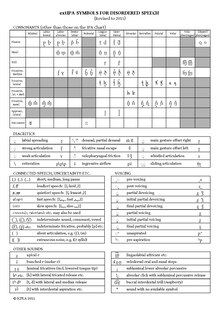Bảng mẫu tự ngữ âm quốc tế mở rộng
Bạn có thể mở rộng bài này bằng cách dịch bài viết tương ứng từ Tiếng Anh. Nhấn [hiện] để xem các hướng dẫn dịch thuật.
|
Bảng mẫu tự ngữ âm quốc tế mở rộng (thường được viết tắt là extIPA /ɛkˈstaɪpə/)[1] là tập hợp các chữ cái và dấu phụ được đưa ra bởi Hiệp hội Ngữ âm và Ngôn ngữ học Lâm sàng Quốc tế nhằm mục đích phiên âm giọng nói rối loạn bằng cách tăng cường bảng mẫu tự ngữ âm quốc tế. Một số ký tự được dùng để phiên âm các đặc điểm của giọng nói thường trong phiên âm IPA và được chấp nhận bởi Hiệp hội Ngữ âm Quốc tế.[a]

Vào năm 2015, extIPA đã được sửa đổi và mở rộng; các ký tự mới được thêm vào Unicode vào năm 2021.[2]
Chú thích
sửa- ^ Ví dụ như tiếng !Xoon có âm phụt trước hữu thanh ⟨ˬɡ̥xʼ⟩ trong Bennett 2020, tr. 102
- ^ Ball 1993, tr. 39-41
- ^ Miller, Kirk; Ball, Martin J. (2020). “Unicode request for extIPA support” (PDF). Unicode. L2/20-039.
Tham khảo
sửa- Ball, Martin J. (1993). “Further to Articulatory Force and the IPA Revisions”. Journal of the International Phonetic Association. 23 (1). doi:10.1017/S0025100300004783. S2CID 143614464.
- Ball, Martin J.; Esling, John H.; Dickson, Craig (tháng 12 năm 1995). “The VoQS System for the Transcription of Voice Quality”. Journal of the International Phonetic Association. 25 (2): 71–80. doi:10.1017/S0025100300005181. S2CID 145791575.
- Ball, Martin J.; Howard, Sara J.; Miller, Kirk (2018). “Revisions to the extIPA chart”. Journal of the International Phonetic Association. 48 (2): 155–164. doi:10.1017/S0025100317000147. S2CID 151863976.
- Ball, Martin J.; Lowry, Orla M. (2001). “Transcribing Disordered Speech”. Methods in Clinical Phonetics. London: Whurr. tr. 25–40, 80. doi:10.1002/9780470777879.ch3. ISBN 9781861561848. S2CID 58518097.
- Bennett, William G. (2020). “Click Phonology”. Trong Sands, Bonny (biên tập). Click Consonants. Empirical Approaches to Linguistic Theory. 15. Brill. tr. 74–128. doi:10.1163/9789004424357_003. ISBN 978-90-04-23268-6. S2CID 243697259.
- Duckworth, Martin; Allen, George; Hardcastle, William; Ball, Martin J. (1990). “Extensions to the International Phonetic Alphabet for the transcription of atypical speech”. Clinical Linguistics and Phonetics. International Clinical Phonetics and Linguistics Association. 4 (4): 273–280. doi:10.3109/02699209008985489.
- Hesselwood, Barry; Howard, Sara (2008). “Clinical Phonetic Transcription”. Trong Ball, Martin J.; Perkins, Michael R.; Müller, Nicole; Howard, Sara (biên tập). The handbook of Clinical Linguistics. Malden, MA: Blackwell. doi:10.1002/9781444301007.ch23. ISBN 9781405135221.
- International Phonetic Association (1999). Handbook of the International Phonetic Association : a guide to the use of the International Phonetic Alphabet. Cambridge, UK: Cambridge University Press. ISBN 9780521637510.
- Ladefoged, Peter (1971). Preliminaries to linguistic phonetics. Chicago, IL: University of Chicago Press. ISBN 0-226-46787-2. LCCN 75-179318.
- Laver, John (1994). Principles of phonetics. Cambridge Textbooks in Linguistics. Cambridge, UK: Cambridge University Press. doi:10.1017/CBO9781139166621. ISBN 9781139166621.
- van der Voort, Hein (2005). “Kwaza in a Comparative Perspective”. International Journal of American Linguistics. University of Chicago Press. 71 (4): 365–412. doi:10.1086/501245. S2CID 224808983.